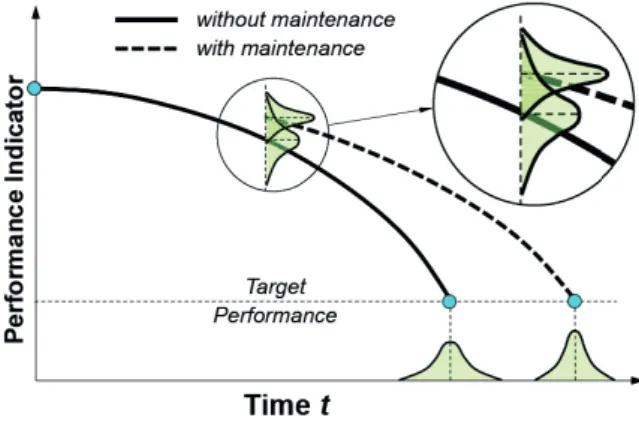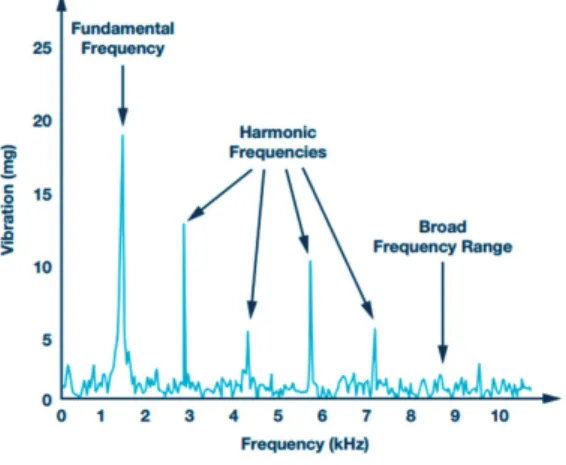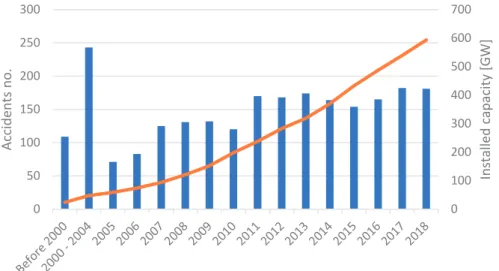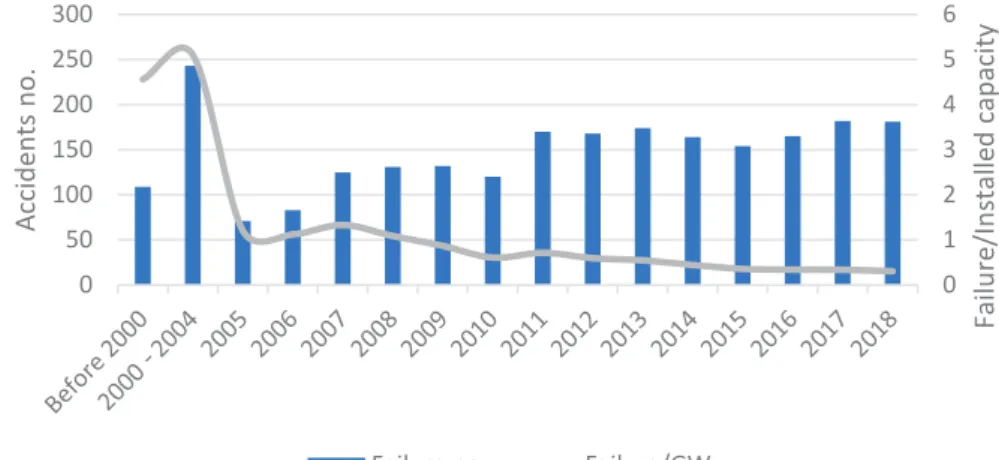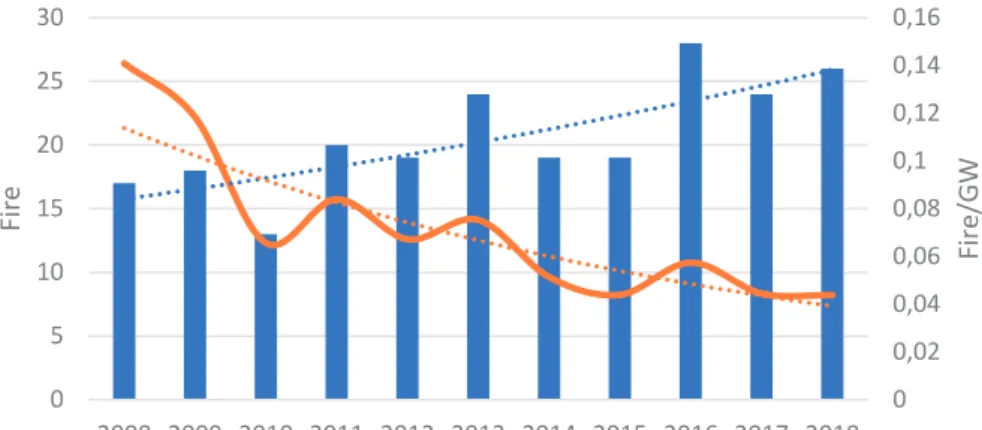KÖZLÖNY
Csaba Hetyei
1– Rudolf Nagy
2Review of Wind Turbine Failures, Highlighting Fire Accidents
Szélturbinák meghibásodásainak áttekintése, kiemelve a tűzeseteket
Modern military doctrines are increasingly emphasising the ability to autonomously use the capabilities supported by military infrastructure networks. Therefore, in the theatres of military operations, the temporary facilities should provide their own increasing energy needs. Military energetic engineers are increasingly exploring the technical solutions of energy production in camp environments.
In this article, not taking into consideration traditional fossil fuel technology, we concentrate on the renewable energy sources, especially the wind turbines. The wind energy utilisation can be a good solution for mobility and environmental aspects: released harmful material and noise level are lower than in the case of industrial generators. However, the technical safety of wind power plants requires improvement of human, environmental and fire safety.
In this article, we will scope the wind turbine failures and highlight the fire accidents and the protection against them.
Keywords: energy, energy safety, fire, maintenance, smoke detector, wind turbine
Modern katonai doktrínák egyre inkább kiemelik a katonai infrastruktúrák autonóm működési képességeit. Egy adott ország infrastrukturális hálózatától távoli hadműveleti területeknek saját maguknak kell biztosítaniuk energiaforrásaikat, amely évről évre növekvő trendet mutat az elektronikai eszközök terjedésének köszönhetően. Taktikai bázisok méretétől függően a hadipari energetikai mérnökök a szükséges energiaszint biztosítására egyre nagyobb figyelmet fordítanak.
1 Óbuda University, Doctoral School on Safety and Security Sciences, PhD Student, e-mail: hetyei.csaba@phd.
uni-obuda.hu, ORCID: https://orcid.org/0000-0003-2915-4540
2 Engineer Colonel (Ret.), Óbuda University, Donát Bánki Faculty of Mechanical and Safety Engineering, Associate professor, e-mail: nagy.rudolf@bgk.uni-obuda.hu, ORCID: https://orcid.org/0000-0001-5108-9728
Cikkünkben a hagyományos energiaforrásokat figyelmen kívül hagyva a megújuló energiaforrá- sokra koncentrálunk, közülük is a szélturbinákra. A szélenergia hasznosítása kellő technikai háttérrel egy mobil megoldás, amelynek károsanyag- és zajkibocsátása alacsonyabb az ipari aggregátorokéhoz képest. A szélerőművek műszaki biztonságának ismeretében a humán és a környezeti biztonság javítható, az energiatermelés fenntartható. Cikkünkben a szélturbinák műszaki meghibásodásait vizsgáljuk meg, ezek közül is kiemelve a tűzeseteket és azok megelőzési módjait.
Kulcsszavak: energia, energiabiztonság, tűz, karbantartás, füstérzékelő, szélturbina
1. Introduction
In today’s increased demand for energy, renewable energy sources started to be in the focus.
By viewing any global trend for the renewables’ market share year to year, we can observe a growing rate. For example, in a UNEP (United Nations Environment Programme) review3 we can see that the global new investment in renewable energy was in 2004 $47 billion, in 2008
$181 billion, in 2012 $255 billion, in 2016 $274 billion, in 2017 $280 billion. On the other hand, the green, carbon-free energy demand is also increasing. The European Union has set a binding target for the energy consumption: 20% will come from renewable sources by 2020, and 32%
will come by 2030.4
Thanks to the growing number of wind turbines, their size, mobility and usability are changing. Using the IEC 61400-2 (Wind turbines – Part 2: Small wind turbines) standard or the Canadian Wind Energy Association (CanWEA) standards we can group the wind turbines by their size and associate a possible field of use for military purpose. According to the CanWEA’s study, the ‘large-size’ wind turbines have more than 300 kW installed capacity, the ‘mid-sized’ are between 30 to 300 kW, the ‘small-sized’ from 1 to 30 kW, and up to 1 kW they are the ‘mini’ or ‘micro-size’ turbines.5 The typical size of these turbines can be seen in Figure 1.
3 Global trends in renewable energy investment 2018, Frankfurt School – UNEP Centre, 2018. Available: www.
iberglobal.com/files/2018/renewable_trends.pdf (22. 10. 2020.)
4 ‘Renewable energy. Moving towards a low carbon economy,’ European Commission. Available: https://ec.europa.
eu/energy/en/topics/renewable-energy (06. 03. 2019.)
5 Small Wind Siting And Zoning – Study Development Of Sitting Guidelines And A Model Zoning By-Law For Small Wind Turbines (Under 300 kW), Developed for the Canadian Wind Energy Association. Prepared by eFormative Options LLC. and Entegrity Wind Systems Inc., 2006. Available: www.toolkit.bc.ca/sites/default/files/Small_
Wind_Siting_Bylaw%20and%20Guidelines.pdf (22. 10. 2020.)
Figure 1. Typical wind turbine size by capacities
Source: ‘Wind turbines size,’ Electrical Engineering Portal. Available: https://electrical-engineering-portal.com/
wp-content/uploads/wind-turbine-sizes.gif (22. 10. 2020.)
Using these size categories the large-scale and the upper two-thirds of the middle size turbines are base load power plants, the lower one-third can be used on the permanent operation fields, the small and micro-size can be on the temporary operation fields. For the last size, a tactical shelter system can be found in Figure 2.
Figure 2. Tactical shelter system
Source: ‘Tactical shelter system,’ Energy Technologies Inc. Available: www.ruggedsystems.com/images/tss%20 outside.jpg (22. 10. 2020.)
The wind turbines have a couple of components which can lose their reliability and have a failure or damage. If a turbine must stop by failure it causes huge financial damage for the energy company, because it cannot produce energy besides the cost of failure. The main components of a wind turbine are the foundation, tower, nacelle and the rotor (see Figure 3) and the electrical system.
The foundation is usually concrete reinforced by steel under the ground, the tower can be a tubular concrete or a welded or bolted steel structure. The primary components of the nacelle are the hub, bearings, gearboxes, brake, generator, shafts and the yaw system. The main parts of the rotor component group are the blades, the pitch system, the hydraulic unit and the lubrication system.
Most of the electrical components are installed in the nacelle and some are in the rotor and the tower. The electrical components of the wind turbines are the generator, transformer, inverter, rectifier, sensors and electrical control system parts.
Figure 3. Wind turbine parts
Source: ‘Wind turbine parts,’ Wikimedia. Available: https://upload.wikimedia.org/wikipedia/commons/5/52/
EERE_illust_large_turbine.gif (12. 09. 2019.)
For a complex system, there is a complex variety of failures. For example, any sensors can cor- rode, the blades and any rotating or periodically loaded component can have fatigue fracture, the cooling system can be overheated, the gears can have pitting and cracking, the motors can have bearing problems, the lubrication system could clog, the oil tank can leak, the clutches can have misalignments, electric motors, transformers, controllers, components of the measure- ment system can have short circuits. Beyond this list there exist also some other failure issues.
By this list, we can assume the wind turbine is a complex system and its maintenance should also have its complexity; according to Chan and Mo6 and the Caithness Windfarm Information Forum7 (CWIF) the cause of failure can be traced back to the lack of proper maintenance, which can be due to this complexity.
For the required availability and reliability of usage, one maintenance strategy is not enough, thus for the wind turbines, they use a maintenance mix, which is better for the structural and functional integrity (and financially). For a better understanding of the wind turbines mainte- nance system, Chan and Mo simulated a wind turbine with a maintenance mix and specified
6 Daniel Chan and John Mo, ‘Life cycle reliability and maintenance analyses of wind turbines,’ Energy Procedia 110 (2017), 328–333.
7 ‘Summary of Wind Turbine Accident data to 31 December 2018,’ Caithness Windfarm Information Forum, 2019. Available: www.caithnesswindfarms.co.uk/accidents.pdf (12. 03. 2019.)
a lifetime for the component. Heller8 was using statistical analysis to find a wind turbine’s power curve, which can be used for precise design.
If we speak about failure, we should mention that there are some countries with the proper law or regulation for the protection of life and the urban region. For example Bavaria in 2016 passed an act according to which minimum 2 km distance between the habitable region and the wind turbines must be kept. Scotland in 2014 has suggested increasing the same distance from the current 2 km to 2.5 km.9
2. About wind turbines maintenance strategies
According to DIN EN 13306:2010,10 maintenance is a ‘combination of all technical administrative and managerial actions during the life cycle of an item intended to retain it in, or restore it to, a state in which it can perform the required function’.
According to Chan and Mo, for the components of the wind turbine the breakdown replace, the scheduled service or replace and the condition based repair are used as maintenance strat- egies. We can speak about the breakdown replacement when the component’s performance indicator decreases under the critical level and it cannot perform its task (continuous line in Figure 4). If we use scheduled service for maintenance strategy, we estimate the performance indicator’s decrease, and at a specific time, we perform a maintenance procedure for increasing the performance indicator. In the performance indicator function, it can be a sharp increase or a longer slope (dashed line in Figure 4).
Figure 4. The change of the performance indicator over time
Source: Fabio Biondini and Dan M. Frangopol, ‘Life-Cycle Performance of Deteriorating Structural Systems under Uncertainty: Review,’ Journal of Structural Engineering 142, no 9 (2016)
8 Arnie Heller, ‘Predicting Wind Power with Greater Accuracy,’ Lawrence Livermore National Laboratory, S&TR, 2014. Available: https://str.llnl.gov/content/pages/april-2014/pdf/04.14.1.pdf (22. 10. 2020.)
9 ‘Wind Turbine,’ 2019, 5.
10 DIN EN 13306:2010: Maintenance – Maintenance terminology.
If we use the condition-based maintenance strategy, we must measure the component(s) performance indicator periodically or continuously depending on the importance of the parts.
With the required amount and quality of data, with some statistical tool, we can estimate the component(s) lifetime and we can decrease the failure probability. This measurement can exemplify the working tolerance, vibration spectrum analysing, discontinuity density mea- surement and so on.
The prediction (for vibration spectrum analysis) starts with a frequency measurement in which we measure in the time domain and we decompose the measured signal with an FFT algorithm to the frequency domain. In the frequency domain, we can identify the component fundament frequency and its harmonic components and some notable frequencies depending on the component(s). With a repeated measurement we can observe the changing of the peaks in low and high frequency ranges. Based on the change of amplitude and the available expert system’s knowledge, a software can estimate us the remaining lifetime. In Figure 5 we can see the spectrum of a rotating component.
With this methodology we can decrease the errors caused by vibration, preventing problems like overheating, or we can couple this measurement system with other sensors (for example heat). Depending on the other linked data type, we can or we should use different mathematical pre-processing tools for the raw data, for example, for temperature measurements we have to measure in the time domain and we have to compare the peak value (if the peak value carries information for the failure process).
Figure 5. Vibration spectrum plot
Source: Thomas Brand, ‘Demands on Sensors for Future Servicing: Smart Sensors for Condition Monitoring,’
Analog Digital. Available: www.analog.com/en/technical-articles/a60151-demands-on-sensors-for-future-servic- ing-smart-sensors-for-condition-monitoring.html (22. 10. 2020.)
For a wind turbine farm, the management of the different types of data (measured, processed and stored data) seems a hard an almost impossible task, thus the wind farm’s operators use a SCADA system (Supervisory Control and Data Acquisition).
3. The cause of failure of wind turbines
By statistics from the CWIF (Caithness Windfarm Information Forum) we can see that from 30 November 1980 there were 2372 failures until 31 December 2018. In the next figure (Figure 6), for the above mentioned time interval we can see the failure distribution versus the cumulative capacity of installed wind turbines.
0 100 200 300 400 500 600 700
0 50 100 150 200 250 300
Installed capacity [GW]
Accidents no.
Figure 6. Wind turbines accident number vs. cumulative installed capacity
Sources: Compiled by the authors using the data of CWIF, Global Wind Energy Council, Wind Power Capacity Worldwide Reaches.11
About Figure 6 we can establish that the number of failures is increasing year by year, as well as the installed capacity. If we divine the failures by the installed capacity (for a specific failure rate) we have a decreasing trend (Figure 7), which can be due to the design, manufacturing, technology and maintenance systems improvements.
11 ‘Wind Turbine,’ 2018; ‘Wind Turbine,’ 2019, 5; ‘Global Wind Statistics 2017,’ Global Wind Energy Council, Brussels, 2018. Available: https://gwec.net/wp-content/uploads/vip/GWEC_PRstats2017_EN-003_FINAL.pdf (22. 10. 2020.); ‘Wind Power Capacity Worldwide Reaches: 600 GW, 53,9 GW added in 2018,’ WWEA. Available:
https://wwindea.org/information-2/information/ (12. 03. 2019.)
0 1 2 3 4 5 6
0 50 100 150 200 250 300
Failure/Installed capacity
Accidents no.
Failure no. Failure/GW
Figure 7. Wind turbines reliability: Failure number vs. Failure number/installed capacity
Sources: Compiled by the authors using the data of CWIF, Global Wind Energy Council, Wind Power Capacity Worldwide Reaches.12
According to the CWIF statistics about the total 2,372 failures, blade failures were the most frequent with 395, fire was the 2nd with 344, and structural failures were the 3rd with 205 re- ported cases. In the next figures (Figure 8, 9 and 10), we can see the last 10 years’ blade, fire and structural failures with trend curves. In the next three diagrams, the blue trend curve represents a trend in the number of failures, the orange the failure number divided by the installed capacity.
0 0,02 0,04 0,06 0,08 0,1 0,12 0,14 0,16 0,18 0,2
0 5 10 15 20 25 30 35 40
2008 2009 2010 2011 2012 2013 2014 2015 2016 2017 2018
Blade failure/GW
Blade failure
Figure 8. The last ten years’ blade failures
Sources: Compiled by the authors using the data of CWIF, Global Wind Energy Council, Wind Power Capacity Worldwide Reaches.13
12 ‘Wind Turbine,’ 2018, 8; ‘Wind Turbine,’ 2019, 5; ‘Wind Power Capacity,’ 8; ‘Worldwide Reaches,’ 8.
13 ‘Wind Turbine,’ 2018, 8; ‘Wind Turbine,’ 2019, 5; ‘Wind Power Capacity,’ 8; ‘Worldwide Reaches,’ 8.
0 0,02 0,04 0,06 0,08 0,1 0,12 0,14 0,16
0 5 10 15 20 25 30
2008 2009 2010 2011 2012 2013 2014 2015 2016 2017 2018
Fire/GW
Fire
Figure 9. The last ten years’ fire accidents
Sources: Compiled by the authors using the data of CWIF, Global Wind Energy Council, Wind Power Capacity Worldwide Reaches.14
0 0,02 0,04 0,06 0,08 0,1 0,12
0 2 4 6 8 10 12 14 16 18
2008 2009 2010 2011 2012 2013 2014 2015 2016 2017 2018
Structural failure/GW
Structureal failure
Figure 10. The last ten years’ structural failures
Sources: Compiled by the authors using the data of CWIF, Global Wind Energy Council, Wind Power Capacity Worldwide Reaches.15
Viewing the trend curves, we can estimate a decreasing trend for the blade failures, a slightly decreasing curve for the structural failures and an increasing one for the fire accidents. If we observe the trend curves of the failure specific rates in each case, we find a decreasing value.
14 ‘Wind Turbine,’ 2018, 8; ‘Wind Turbine,’ 2019, 5; ‘Wind Power Capacity,’ 8; ‘Worldwide Reaches,’ 8.
15 ‘Wind Turbine,’ 2018, 8; ‘Wind Turbine,’ 2019, 5; ‘Wind Power Capacity,’ 8; ‘Worldwide Reaches,’ 8.
4. About wind turbine fire
According to the CWIF’s data,16 fire accident is the second most common wind turbine failure, and according to the previous figures (Figure 8, Figure 9 and Figure 10) it is the only failure which has an increasing trend, too (for the incident frequency).
In a wind turbine, each element for the fire triangle is there, the wind provides the oxygen, the ignition source can be the light strike or an electric equipment malfunction, hot surface or hot working maintenance task (flame cutting, welding, soldering, abrasive cutting) and the fuel can contain any flammable materials, for example the hydraulic or the lubrication oil, the polymers and the insulations.17
4.1. Fire detection (active fire protection system components)
For fire detection, there are four types of detectors: heat, smoke, flame and fire gas detectors.
These can measure components of fire, such as IR or UV light radiation, heat, smoke or gas.
The heat detector measures the thermal energy, it is generally less sensitive, thus they cause fewer false alarm. Generally, there are two kinds of heat detectors, the fixed temperature heat detector, which operates a heat-sensitive eutectic alloy, and the Rate-of-Rise detector, which measures the change of temperature in time.18
The smoke detectors can detect the visible (more than 5 microns) and invisible aerosol particles (like ions, gas molecules).
The smoke detectors cause more false alarms than heat detectors because they respond faster. This speed is not an advantage in dusty, dirty places with relatively high wind on the nacelle. These type of detectors can work with different technologies, like ionisation and photoelectricity.
The detector with ionisation technology ionises the air, which can flow in two different chambers in the detector. If the pairs of chamber electrodes have different voltage potential, it means there is smoke, which produces a different electrical current than the ionised air. The photoelectric (or optical smoke detectors) contains IR, visible or UV light, lens and a photo- electric receiver. If the light intensity reduces, the receiver has a different sign and sends a ‘fire’
alert. The ionisation smoke detectors are usually cheaper than the optical, they may be more prone to a false alarm and they have slower response time than the optical detectors.
The flame detectors can detect only the visible fire spreading. These type of detectors work with IR, UV separately, and with combined optical sensors. These sensors cannot work when there are some effects which makes difficult the sensor’s vision.
The gas detectors can detect the gas molecules, usually CO. They can detect a wide range of molecules, with various methods. They can detect well in stationary, not ventilated air.
16 ‘Wind Turbine,’ 2018, 8.
17 Sylvester Uadiale, Évi Urbán, Ricky Carvel, David Lang and Guillermo Rein, ‘Overview of Problems and Solutions in Fire Protection Engineering of Wind Turbines,’ Fire Safety Science 11 (2014), 983–995.
18 Ibid.
4.2. Fire prevention (passive fire protection system components)
We can fight against fire with passive protection, too, like the structural redesign, for example installing fire barriers near the flammable components, simulating fire scenarios19 and reinforc- ing the fire extinguishing system in the required regions. Or with different material selection, like using non-combustible lubrication and hydraulic oil, and less flammable materials if it is possible. Another kind of passive protection is the more effective maintenance, planning with less sparkling reparation fieldwork and more accurate monitoring system.
4.3. Fire extinguishing system
Viewing the task of fire extinguishing from a different perspective, the wind turbine fires cannot be eliminated with 100% possibility, hence a more efficient extinguishing system is required.
For the currently available wind turbine, the most difficult task is the fire elimination, because the on-shore wind turbines are located at high altitudes, and the off-shore wind turbines are located deep in the bays. If the wind turbines start to burn, they mean a high risk for human life and the environment. Installing a fixed fire extinguishing system for on-shore and off-shore places is expensive and sometimes it is almost an impossible task. With the available technol- ogies, a fire extinguishing drone20 with an installed or cable connected extinguisher system is a possibility for these places and altitudes.
5. Summary
For military and civil use, the wind turbine utilisation is a key renewable energy source. By the technological enhancements, we can find more and more mechanical and electronic devices in the wind turbines. This increasing number of components means a higher possibility to have a part with malfunctions. This part may cause life expectancy decrease in the structural or functional integrity of the wind turbine.
In this paper, we reviewed the utilisation of wind turbines, their parts, and the types of their failures. Then we presented the possible maintenance strategies and tools. Later we examined the statistical data about the wind turbine failures: according to the data, blade failures are the most frequent, fire is the second and structural damage is the third most common failure.
According to the trend of these accidents (projected to installed capacity), we established that the frequency of blade failures is decreasing, that of structural failures is constant, and that of fire accidents is increasing. After the statistical analysis, we reviewed the fire protection systems.
Knowing the possible accidents, the occasional mechanical and electrical disturbances are detectable and repairable if it is necessary. An unexpected failure, depending on the location
19 Borja Rengel, Elsa Pastor, Daniel Hermida, Emiliano Gómez, Lisa Molinelli and Eulàlia Planas, ‘Computational Analysis of Fire Dynamics Inside a Wind Turbine,’ Fire Technology 53, no 2 (2017), 1–10.
20 András Nagy and Ingo Jahn, ‘Advanced Data Acquisition System for Wind Energy Applications,’ Periodica Poly- technica Transportation Engineering 47, no 2 (2019), 124–130.
of the malfunction, may produce a loss of electricity production, which in civil use is usually an economical problem, but in military use, it may cause a temporary, partial or complete shutdown of a tactical shelter or a military base.
References
Biondini, Fabio – Frangopol, Dan M.: ‘Life-Cycle Performance of Deteriorating Structural Systems under Uncertainty: Review.’ Journal of Structural Engineering 142, no 9 (2016). DOI: https://doi.
org/10.1061/(ASCE)ST.1943-541X.0001544
Chan, Daniel – Mo, John: ‘Life cycle reliability and maintenance analyses of wind turbines.’ Energy Procedia 110 (2017), 328–333. DOI: https://doi.org/10.1016/j.egypro.2017.03.148
Nagy, András – Jahn, Ingo: ‘Advanced Data Acquisition System for Wind Energy Applications.’ Periodica Polytechnica Transportation Engineering 47, no 2 (2019), 124–130. DOI: https://doi.org/10.3311/
PPtr.11515
Rengel, Borja – Pastor, Elsa – Hermida, Daniel – Gómez, Emiliano – Molinelli, Lisa – Planas, Eulàlia:
‘Computational Analysis of Fire Dynamics Inside a Wind Turbine.’ Fire Technology 53, no 2 (2017), 1–10. DOI: https://doi.org/10.1007/s10694-017-0664-0
Uadiale, Sylvester – Urbán, Évi – Carvel, Ricky – Lang, David – Rein, Guillermo: ‘Overview of Problems and Solutions in Fire Protection Engineering of Wind Turbines.’ Fire Safety Science 11 (2014), 983–995. DOI: https://doi.org/10.3801/IAFSS.FSS.11-983
Internet references
Brand, Thomas: ‘Demands on Sensors for Future Servicing: Smart Sensors for Condition Monitoring.’
Analog Digital. Available: www.analog.com/en/technical-articles/a60151-demands-on-sen- sors-for-future-servicing-smart-sensors-for-condition-monitoring.html (22. 10. 2020.)
Global trends in renewable energy investment 2018. Frankfurt School – UNEP Centre, 2018. Available:
www.iberglobal.com/files/2018/renewable_trends.pdf (22. 10. 2020.)
‘Global Wind Statistics 2017.’ Global Wind Energy Council, Brussels, 2018. Available: https://gwec.net/
wp-content/uploads/vip/GWEC_PRstats2017_EN-003_FINAL.pdf (22. 10. 2020)
Heller, Arnie: ‘Predicting Wind Power with Greater Accuracy.’ Lawrence Livermore National Labo- ratory, S&TR, 2014. Available: https://str.llnl.gov/content/pages/april-2014/pdf/04.14.1.pdf (22. 10. 2020.)
‘Renewable energy. Moving towards a low carbon economy.’ European Commission. Available: https://
ec.europa.eu/energy/en/topics/renewable-energy (06. 03. 2019.)
Small Wind Siting And Zoning – Study Development Of Sitting Guidelines And A Model Zoning By-Law For Small Wind Turbines (Under 300 kW). Developed for the Canadian Wind Energy Association.
Prepared by eFormative Options LLC. and Entegrity Wind Systems Inc., 2006. Available:
www.toolkit.bc.ca/sites/default/files/Small_Wind_Siting_Bylaw%20and%20Guidelines.pdf (22. 10. 2020.)
‘Summary of Wind Turbine Accident data to 31 December 2018.’ Caithness Windfarm Information Forum, 2019. Available: www.caithnesswindfarms.co.uk/accidents.pdf (12. 03. 2019.)
‘Tactical shelter system.’ Energy Technologies Inc. Available: www.ruggedsystems.com/images/tss%20 outside.jpg (22. 10. 2020.)
‘Wind Power Capacity Worldwide Reaches: 600 GW, 53,9 GW added in 2018.’ WWEA. Available:
https://wwindea.org/information-2/information/ (12. 03. 2019.)
‘Wind Turbine Accident and Incident Compilation.’ Caithness Windfarm Information Forum, 2018 and 2019. Available: www.caithnesswindfarms.co.uk/fullaccidents.pdf (12. 03. 2019.)
‘Wind turbine parts.’ Wikimedia. Available: https://upload.wikimedia.org/wikipedia/commons/5/52/
EERE_illust_large_turbine.gif (12. 09. 2019.)
‘Wind turbines size.’ Electrical Engineering Portal. Available: https://electrical-engineering-portal.com/
wp-content/uploads/wind-turbine-sizes.gif (22. 10. 2020.)
Legal References
DIN EN 13306:2010: Maintenance – Maintenance terminology.


